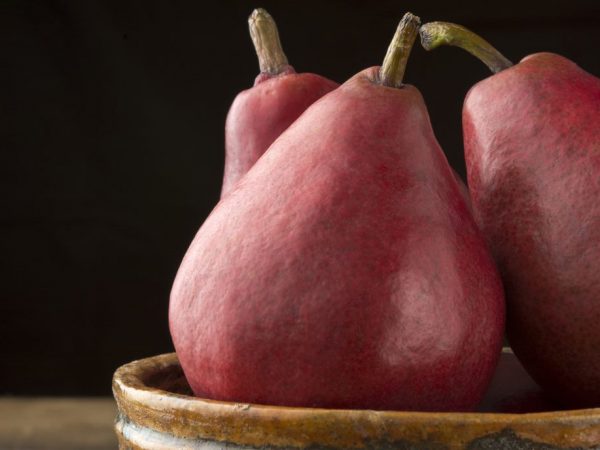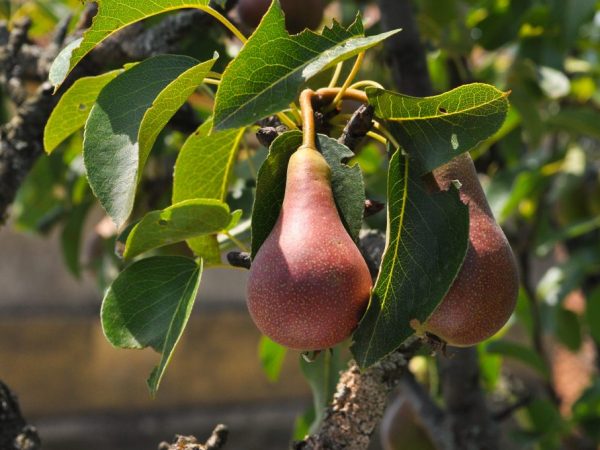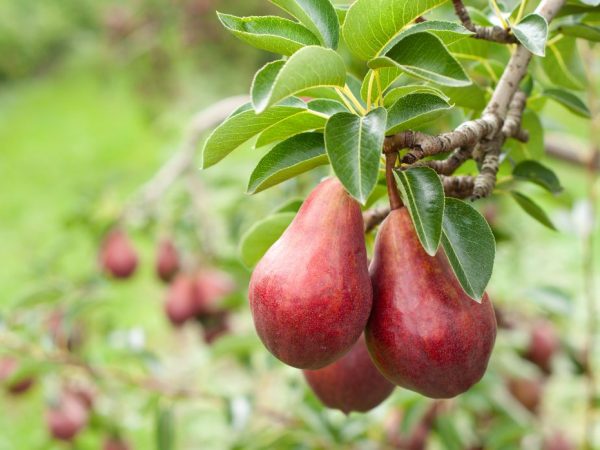Characteristics of Starkrimson pears
Starkrimson pear is one of the most popular pear varieties. The main advantage is a high yield level.

Characteristics of Starkrimson pears
Characteristics of the variety
Starkrimson, although it ripens by the end of summer, is a winter-hardy and drought-resistant variety.
Ripening period - end of July-August. Reaches its fertility at 5-7 years. The highest productivity is observed around the 10th year of cultivation. The Starkrimson pear bears fruit for 15 to 20 years.
Description of the tree
The tree is vigorous. According to the description of the variety, trees can reach lengths of up to 5 m. They have abundant foliage, spreading. The main advantage is regular fruitfulness.
Leaves are dark green, narrow, 3-10 cm long. The tip is pointed. ...
When planting, pollinating plants are used, such as "Conference", "Williams", "Panna", etc. Landing occurs in the spring, less often in the fall. The first seedlings yield a harvest in 2 years. Bare root seedlings should not be stored for long. Immediate planting is required.
Description of the fetus
The description shows that the ripe fruit has a mass of 180-250 grams. The shape is standard pear-shaped or rounded-elongated. Starkrimson pear has a deep red color with a burgundy sheen. The surface of the pear is smooth.
Characteristics of Sotra Starkrimson fruits:
- juicy white pulp;
- rich sweet-sour taste;
- pleasant aroma.
With such an attractive appearance and taste, Starkrimson is used in cooking for the preparation of sweet, dietary meals. Can be an ingredient in jam, jam, jam. Perfect for compotes and liqueurs. It is often sold dried to retain its beneficial properties.
Care

Good care will increase the yield of the tree
The plant requires timely care.
Consider the factors that affect the level of yield and the quality of the fruit.
Seat selection
This variety loves loose, clay-containing, moist soil. It is worth choosing places protected from the sun and wind. Withstands long periods without watering, but should not be neglected.
Landing
Preferably in the spring. It is necessary to prepare the soil mixed with organic and mineral fertilizers. When planting trees, the border of the rootstock and the scion should be located at or slightly above the ground.
Pollination
The tree is self-pollinated. But in some problem situations, additional pollination is necessary. For this, quince is suitable.
Circumcision
Pruning of pear seedlings is carried out in the early spring before the onset of the bud awakening period. It is necessary for the formation of the crown.
Soil mulching
This means covering the soil in the planting area with organic and inorganic agents. Mulching is necessary to protect the land around the tree from weeds. It provides insulation for the root zone during winter periods.
Watering

Water the tree as needed
The watering rate for plants varies from 20 to 30 liters of water per 1 m2.If heavy meteorological precipitation occurs, there is no need for additional watering. After this procedure, it is necessary to thoroughly loosen the soil in the near-trunk area.
Fertilizer
It is important to carry out top dressing in a timely manner. If planting is carried out in the spring, the first feeding will be in the 2nd year. In the case of planting in the fall, the next time feeding is carried out a year later in the spring.
Autumn feeding is necessary to replenish nutrients and prepare for a low temperature regime. Fertilizers are applied by digging into the area of the trunk circle.
For spring feeding, you will need fertilizers containing nitrogen. This will affect the number of future inflorescences and the quality of the fruit. Summer dressing is carried out on the basis of potash and phosphorus fertilizers. They will give the fruit a great appearance.
Pests
Fruit trees are especially susceptible to pests:
- pear mites;
- bedbugs;
- itching;
- fruit crops;
- daytime butterflies;
- hawthorn caterpillars;
- apple flower beetle.
To combat these parasites, chemicals are used (Nitrafen, Karbofos, BI-58, Fufanon.
For preventive purposes, mineral fertilizers containing calcium can be used. The goal is to protect the root system. Spraying takes place before and after flowering.
Diseases
The Starkrimson pear has an average resistance to such diseases as scab. The main characteristics of the disease:
- the causative agent is the fungus Venturia pirina, which manifests itself on the leaves from the lower side of the plate;
- dark green spots that soon turn brown;
- leaves turn yellow and fall off;
- the fungus spreads to the bark of a tree, stalk, petioles and flowers;
- in the fight against scab, spoiled fruits are collected and destroyed.
Another pest is fruit rot. The causative agent is Monilla fructigena. It begins with the spread of dark spots, which gradually turn into brown. The fruits change their color to a lighter color. They soon dry out.
On the surface, there are a large number of small whitish spores, which, in contact with a neighboring fruit, carry infection. Bordeaux mixture is used for treatment. It is sprayed on trees at the time of bud break and immediately after the end of flowering. Diseased fruits are collected and disposed of.
Conclusion
The main advantage of the Starkrimson pear is its high yield. It has an excellent indicator of resistance to disease and frost.
The plant is relatively unpretentious to care for. Timely plant care is the key to a healthy, fruitful plant.


